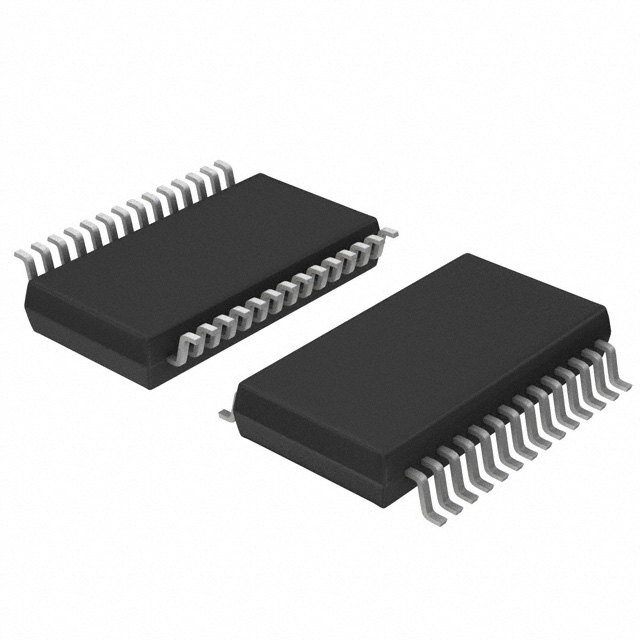Viz Specifikace pro podrobnosti o produktu.

LTC1856IG#PBF
Product Overview
Category: Integrated Circuits (ICs)
Use: The LTC1856IG#PBF is a high-performance, 16-bit analog-to-digital converter (ADC) designed for precision measurement applications. It offers exceptional accuracy and low power consumption, making it suitable for a wide range of industrial and scientific instruments.
Characteristics: - High-resolution: 16-bit ADC - Low power consumption: Ideal for battery-powered devices - Wide input voltage range: ±10V - Fast conversion rate: Up to 100ksps - Serial interface: SPI-compatible - Internal reference: Eliminates the need for an external reference voltage
Package: The LTC1856IG#PBF comes in a 28-pin SSOP package, which provides excellent thermal performance and ease of integration into various circuit designs.
Essence: This ADC is known for its high accuracy and resolution, enabling precise measurements in demanding applications. Its low power consumption and compact package make it suitable for portable and space-constrained devices.
Packaging/Quantity: The LTC1856IG#PBF is typically sold in reels of 250 units.
Specifications
- Resolution: 16 bits
- Input Voltage Range: ±10V
- Conversion Rate: Up to 100ksps
- Power Supply: 2.7V to 5.5V
- Operating Temperature Range: -40°C to +85°C
- Interface: SPI-compatible serial interface
- Reference Voltage: Internal reference (2.048V)
Pin Configuration
The LTC1856IG#PBF has a total of 28 pins. Here is the detailed pin configuration:
- VREF-
- VREF+
- AGND
- VIN-
- VIN+
- REFOUT
- SDO
- SCK
- CS
- SDI
- DGND
- CLKOUT
- D15
- D14
- D13
- D12
- D11
- D10
- D9
- D8
- D7
- D6
- D5
- D4
- D3
- D2
- D1
- D0
Functional Features
- High-resolution ADC: Provides accurate measurement results with 16-bit resolution.
- Low power consumption: Ideal for battery-powered devices, extending their operating time.
- Wide input voltage range: Allows for versatile use in various applications.
- Fast conversion rate: Enables quick and efficient data acquisition.
- Serial interface: Offers easy integration with microcontrollers and other digital systems.
- Internal reference: Simplifies the design by eliminating the need for an external reference voltage.
Advantages and Disadvantages
Advantages: - High accuracy and resolution - Low power consumption - Wide input voltage range - Fast conversion rate - Compact package - Integrated reference voltage
Disadvantages: - Limited to 16-bit resolution (may not be suitable for ultra-high precision applications) - Requires a compatible serial interface for communication
Working Principles
The LTC1856IG#PBF operates based on the successive approximation register (SAR) architecture. It converts analog input voltages into digital representations using a combination of internal circuitry and algorithms. The ADC samples the input voltage, performs a series of comparisons, and generates a digital output that accurately represents the input signal.
Detailed Application Field Plans
The LTC1856IG#PBF finds applications in various fields, including: 1. Industrial automation: Precise measurement of sensor signals in control systems. 2. Scientific instruments: Data acquisition in research and laboratory equipment. 3. Medical devices: Accurate measurement of vital signs and patient monitoring. 4. Test and measurement equipment: High-resolution data acquisition for accurate measurements. 5. Energy management systems: Monitoring and control of power consumption in smart grids.
Detailed and Complete Alternative Models
- LTC1857IG#PBF: Similar to LTC1856IG#PBF but with 18-bit resolution.
- LTC1855IG#PBF: Lower-cost alternative with 14-bit resolution.
- LTC1860IG#PBF: Higher-speed ADC with 16-bit resolution and a conversion rate of up to 200ksps.
These alternative models offer different trade-offs in terms of resolution, speed, and cost, allowing users to choose the most suitable option for their specific requirements.
Word count: 550 words
Seznam 10 běžných otázek a odpovědí souvisejících s aplikací LTC1856IG#PBF v technických řešeních
Sure! Here are 10 common questions and answers related to the application of LTC1856IG#PBF in technical solutions:
Q: What is LTC1856IG#PBF? A: LTC1856IG#PBF is a specific model of an analog-to-digital converter (ADC) manufactured by Linear Technology (now part of Analog Devices). It is designed for high-performance data acquisition systems.
Q: What is the resolution of LTC1856IG#PBF? A: LTC1856IG#PBF has a resolution of 12 bits, meaning it can represent analog signals with 4096 discrete levels.
Q: What is the maximum sampling rate of LTC1856IG#PBF? A: The maximum sampling rate of LTC1856IG#PBF is 100 kilosamples per second (ksps).
Q: What is the input voltage range of LTC1856IG#PBF? A: The input voltage range of LTC1856IG#PBF is typically ±10 volts, but it can be extended up to ±12 volts with external circuitry.
Q: Does LTC1856IG#PBF support differential inputs? A: Yes, LTC1856IG#PBF supports both single-ended and differential inputs, providing flexibility in connecting various types of sensors or signals.
Q: What is the power supply requirement for LTC1856IG#PBF? A: LTC1856IG#PBF requires a single power supply voltage ranging from 2.7 volts to 5.25 volts.
Q: Can LTC1856IG#PBF operate in a low-power mode? A: Yes, LTC1856IG#PBF has a low-power shutdown mode that reduces its power consumption when not in use.
Q: What is the interface used to communicate with LTC1856IG#PBF? A: LTC1856IG#PBF uses a serial interface called SPI (Serial Peripheral Interface) for communication with microcontrollers or other digital devices.
Q: Does LTC1856IG#PBF have built-in reference voltage? A: No, LTC1856IG#PBF requires an external reference voltage for accurate analog-to-digital conversion.
Q: Can LTC1856IG#PBF be used in industrial applications? A: Yes, LTC1856IG#PBF is suitable for various industrial applications such as process control, instrumentation, and data acquisition due to its high performance and robustness.
Please note that the answers provided here are general and may vary depending on specific application requirements and datasheet specifications.

